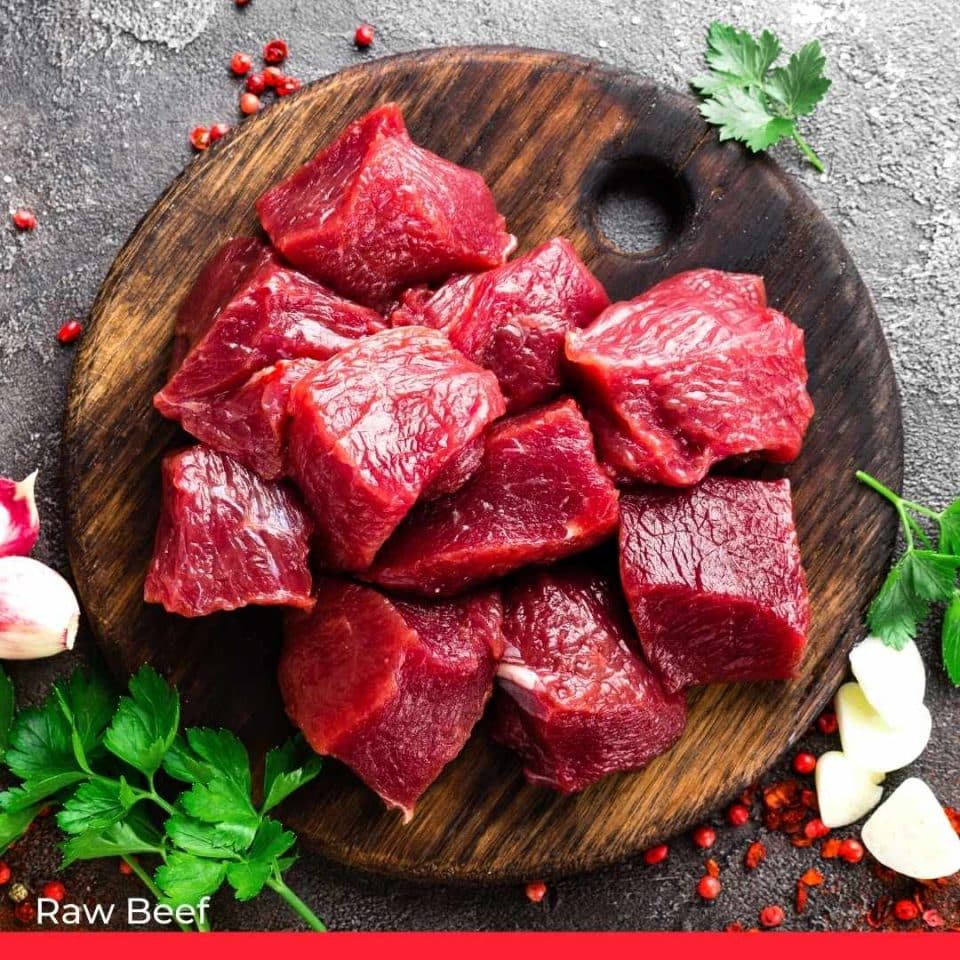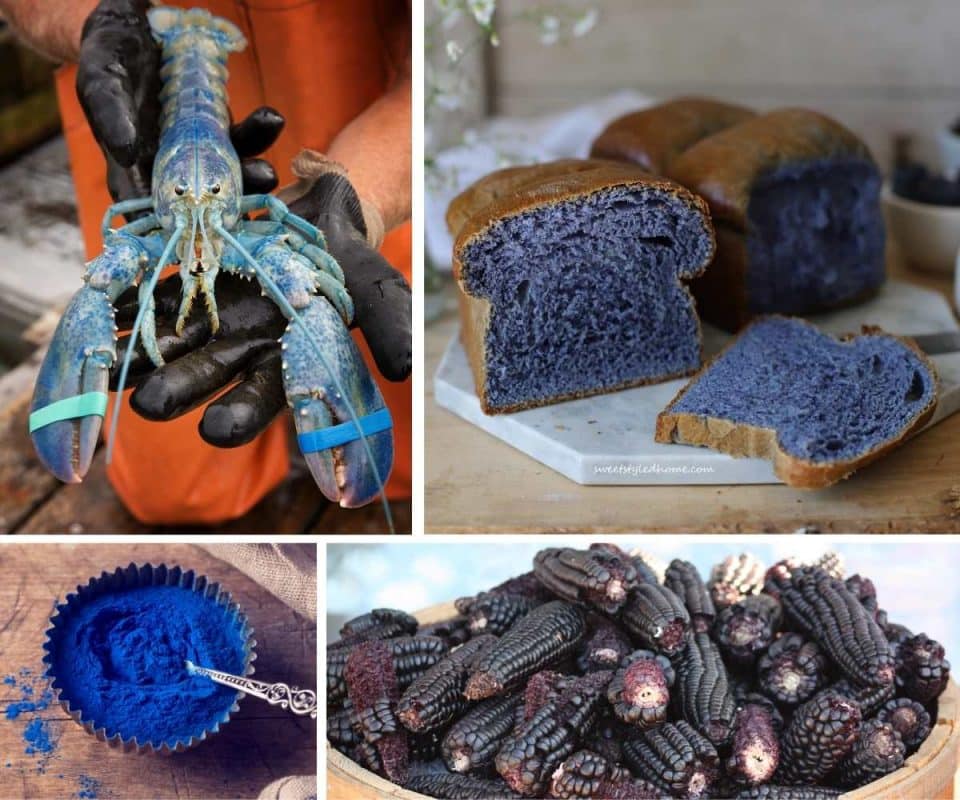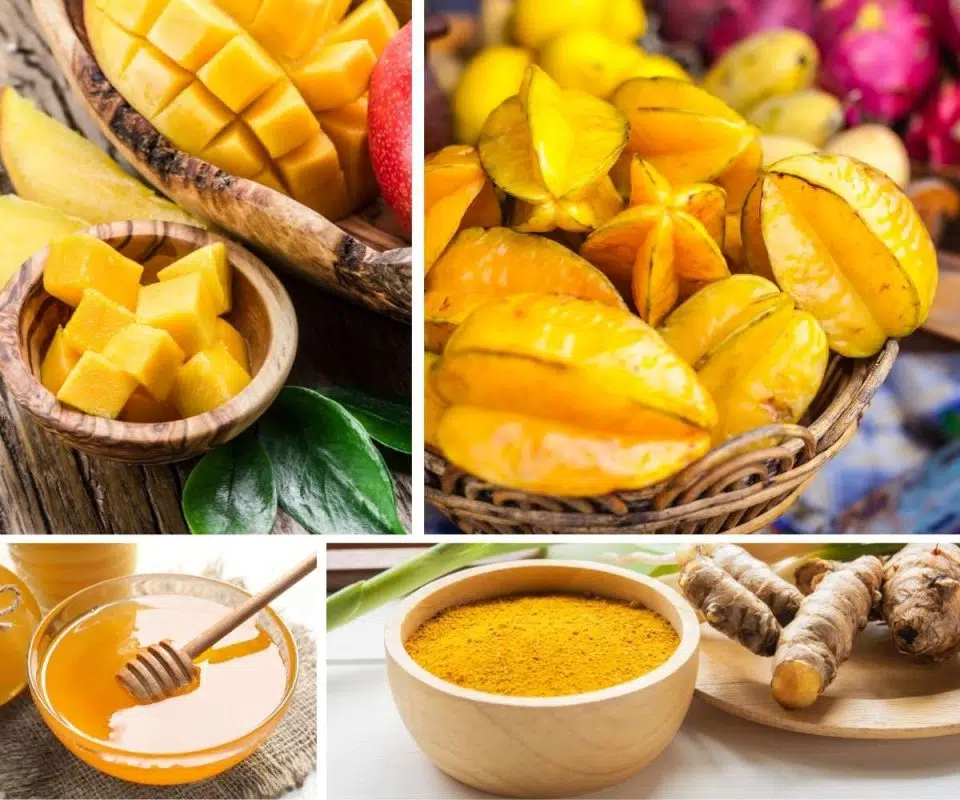25 Naturally Red Foods (With Pictures!)

Looking for a way to add a burst of bright color to your dishes? Or wanting to liven up the color contrasts in your fruit bowl?
To inspire you, we take a look at some of the red-colored foods that will add a vibrant splash of color to any menu!
1. Red Bell Peppers

Bright red bell peppers not only bring a splash of color to salads but there’s also no end to how they can be used: raw and crunchy in salads; blitzed to add sweetness to smoothies; as pizza toppings.
They can be grilled, roasted, baked, or stir-fried and are found in almost every cuisine worldwide.
2. Cranberries

The cranberry is a native wetland plant that likes cool weather and is primarily grown in Wisconsin, Massachusetts, Oregon, and New Jersey. Cranberries are closed related to blueberries, but due to their natural sourness, they’re not often eaten raw.
Americans consume 80 million pounds of cranberries during Thanksgiving, including 5,062,500 gallons of jellied cranberry — enough to fill nearly eight Olympic-sized swimming pools. Cranberry sauce is a Thanksgiving favorite dish in both the United States and Canada.
When dried, they have a pleasantly tart/sweet taste, making them a valuable addition to granolas and trail mix.
3. Pomegranates

The thick deep orange or red peel conceals the gorgeous jeweled seeds (known as ‘arils’) inside the fruit. A traditional ingredient in Middle Eastern and Persian food, they make a great addition to salads and rice dishes.
Over recent decades they’ve become known worldwide as a superfood because they’re low in calories, packed with antioxidants, and believed to offer many health benefits.
4. Cherries

What is more evocative of summer days than a bowl overflowing with cherries?
Although there’s no end to how you can use them to create mouth-watering desserts, jellies, and sundaes, their sharpness makes them a great partner for pork and duck dishes.
5. Tomatoes

Ok, everyone knows about tomatoes and what you can do with them. In fact, it’s probably quicker to list what you can’t do with them.
But did you know that there are 15,000 varieties worldwide? Or that their name comes from an Aztec word meaning ‘plump thing with a navel’. Or that their name in French – ‘pommes d’amour’, literally means ‘love apples’ due to their reputed aphrodisiac qualities.
6. Loganberries

Loganberries taste like a cross between a raspberry and a blackberry. They’re less sweet than either, so if you serve them raw, add plenty of sugar or sweetened cream.
They make fantastic jellies, jams, and pie fillings and complement sweet-flavored meats such as game or duck.
7. Strawberries

Strawberries are perhaps the most popular berry worldwide. There are more than 10 varieties, each with a distinct flavor and texture. Although they also come in different sizes, they always keep that same heart-shaped, ruby-red flesh and coat studded with tiny golden seeds.
Use in endless ways to create summery pavlovas, cheesecakes, cookies, ice creams and smoothies. Strawberries evoke lazy summer days better than almost anything else.
8. Raspberries

Raspberries are related to the blackberry and the rose. Another soft summer fruit with vibrant color, they’re prized for their sweet yet sharp taste. Enjoyed on their own with fresh cream, thick yogurt, or ice cream, they’re delicious.
They also make fantastic jellies and sauces. Although raspberries are a summer fruit, they freeze well, so they can be enjoyed all year round.
9. Watermelon

What could be more refreshing than a slice of chilled watermelon on a hot summer’s day? The brilliant red flesh, hidden inside the vibrant green skin, is typically studded with glossy black seeds.
It makes a great addition to almost any kind of salad, providing an excellent color contrast to green or white ingredients (such as feta cheese). And, of course, it is the perfect smoothie ingredient, sweet, low in calories, and packed with health-giving nutrients.
10. Raw Beef

Not every country has a tradition of eating raw beef. Still, in some parts of the world, it’s been prepared and consumed without cooking for centuries.
Perhaps the most famous example comes from France, where steak tartare is a popular choice, often served with a raw egg on top.
In Thailand, koi soi is based on minced raw beef marinated with fish sauce, chilies, and lime juice. In Ethiopia, traditional kitfo (or ketfo) mixes raw minced beef and local chili powder with spicy clarified butter.
11. Blood Oranges

On the outside, blood oranges look just like regular oranges, but inside, their juicy, succulent flesh is a rich, deep crimson.
Blood oranges are typically sweeter and less acidic than other oranges. Still, they can be used in all the same ways – to flavor cakes, ice creams, and smoothies or to liven up chicken and duck dishes. And, of course, they’ll brighten up any salad!
12. Goji Berries

Most goji berries are imported from northwest China, although the plants are found throughout Asia and South Africa. Fresh pinky-red goji berries, while slightly sweet, can be bitter.
They’re sweeter when dried but retain their sharp tang: they make fantastic, nutrient-packed additions to granolas and trail mixes. As Martha Stewart suggests, the dry berries can be rehydrated overnight and used to ‘elevate avocado on toast’.
13. Hibiscus Tea

Hibiscus tea is an herbal tea known for its lovely hue, ranging from pink to the deepest ruby red. The flavor is sweet and fruity yet slightly sharp. This stunning beverage makes an ideal healthy alternative to caffeine and sugar-loaded drinks.
14. Kidney Beans

Kidney beans, deep oxblood red on the outside, are pink or white inside. However, their skin retains its color when cooked, so if you want to add dark red hues to your rice dishes, or salads, they’re an obvious choice.
The downside is that dried beans need to be soaked overnight before cooking. Then you must boil them (not just heat or simmer) for at least twenty minutes before eating to remove the toxins inside.
And never use the water you soaked them in for cooking, as it will contain the same toxin you’ve been trying to remove. Nevertheless, they’re a nutritious staple enjoyed by people worldwide, so don’t let all that preparation deter you.
15. Lobster

On the seabed, lobsters are typically a bluey-greeny-brownish color because this provides excellent camouflage. However, their shells turn red when heated, although there’s some debate why this happens.
And while whole lobsters or their claws add a splash of color to a table, the cooked meat inside them should always be white.
16. Muntingia

Also known as the Jamaican Cherry, this tree produces small, sweet, cherry-like fruits. It’s native to the Caribbean, Mexico, and South America.
As they’re not commonly available in supermarkets, the best solution is to buy seeds or a small shrub from a specialist grower and grow your own! You’ll be able to surprise and delight friends and family with this unusual yet delicious alternative to the better-known varieties.
17. Radishes

With their vibrant red skins and brilliant white interior, these peppery beauties add a splash of color to many green salads, cheese platters, and sandwiches.
But did you know that when roasted, they take on a sweet, caramelized flavor and meltingly soft texture? Or try pan-frying them with some shallots, garlic, butter, and herbs for a delicious yet unusual side dish.
18. Redcurrants

Redcurrants are a staple of Northern and Central European cuisine. Tasting like a cross between raspberries and rhubarb, they’re too tart to eat raw. But served with hot vanilla custard – divine!
And they complement cheese plates or add a little burst of sharpness to salads. And like most red fruits, they’re low in calories and packed with antioxidants.
19. Red Apples

There are plenty of red-skinned apple varieties to choose from, depending on the exact shade you’re going for. Sweet Tangos are fantastic all-purpose apples, as are Gala, Envy, and deep ruby Red Delicious.
20. Red Quinoa

High in protein and fiber, red quinoa also has the advantage of being gluten-free. Although it’s not a true grain, it can be cooked and used in the same way as grains such as barley. The soft, chewy texture adds interest to a whole range of dishes.
21. Red Rice

Red rice has a brownish-red bran layer. Grown and used throughout Asia, it does lose some color when cooked, so it’s not the best choice when you’re looking to give your dishes a splash of brilliant red.
On the plus side, it’s nuttier and chewier than polished rice, so it will provide an interesting texture to your meals.
22. Beetroot

Juicy, ruby red beetroots are versatile and can be prepared in many ways. They’re delicious when eaten raw and added to salads and sandwiches.
But they can also be roasted, sautéed, or pureed to make tasty pink hummus.
23. Carmine

Carmine, aka cochineal, isn’t really a food. Instead, it’s a brilliant red food coloring, widely used as an additive and found in all sorts of products.
Unfortunately, not many people realize that it’s still made from the ground-up shells of insects – this isn’t mentioned on labels – so it isn’t suitable for vegetarians or vegans.
24. Caribbean Red Papaya

When the flesh of the Caribbean Red Papaya turns yellow and is slightly soft to the touch, it’s ready to eat. And when you cut it open, you’ll be rewarded with the fragrant, reddish flesh, contrasting beautifully with the glossy black seeds nestling in the center. A gorgeous feast for the eyes, as well as the taste buds!
25. Jujube

Also known as red dates, Chinese dates, and Chinese jujubes, these round, red fruits are now found throughout the US as well as Asia. Sweet and slightly chewy, these tiny fruits can be enjoyed fresh or dried.
Related: 20 Naturally Blue Foods

Related: 20 Naturally Yellow Foods

Related: 20 Tasty Brown Foods


